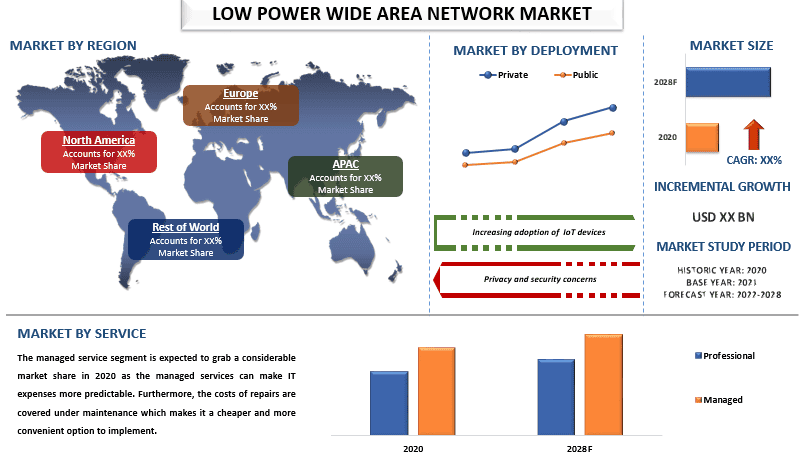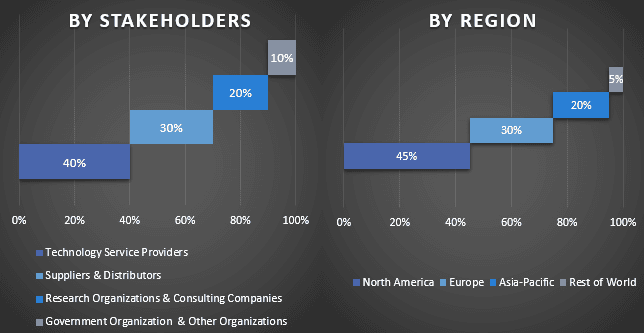- Home
- About Us
- Industry
- Services
- Reading
- Contact Us
Low Power Wide Area Network Market: Current Analysis and Forecast (2022-2028)
Technology type (SIGFOX, LoRaWAN, weightless, and Others), Service (Professional and Managed Services); Deployment (Private, and Public); Application (Waste Management, Smart buildings, Smart gas, and Water metering, Smart streetlights, Smart parking, Livestock monitoring, Others); Industry vertical (agriculture, smart logistics and transportation, healthcare, industrial manufacturing, oil and gas, consumer electronics, and others)

The low power wide area network market is expected to grow with a CAGR of around 79% during the forecast period. Low-power wide-area network is a type of wireless telecommunication wide area network that is designed to allow long-range communications at a low bit rate among things, such as sensors operated on a battery. Low power wide area network provides longer range from 5km to 30km and they consume low power hence provide longer lifetime. Furthermore, low power wide area network requires few numbers of APs i.e. (BSs or Gateways), to cover larger distances across the city or country, it also provides a signal that offers a high amount of penetration through walls and building basements. Additionally, growing developments in the smart cities, smart buildings and increasing adoption of IoT devices is expected to drive the low power wide area network market. The low power wide area network (LPWAN) plays a key role in IoT techniques due to the characteristics of wide coverage and low power consumption. Also, the rapid growth in the investment of smart cities is likely to foster the market’s growth.
For instance, in October 2018, the National Science Foundation (NSF) announced an investment in connected and smart city programs worth USD 22.6 million.
Insights Presented in the Report
“Amongst technology type, the LoRaWAN segment is expected to witness the highest CAGR during the forecast period”
Based on technology type, the market is segmented into SIGFOX, LoRaWAN, weightless, and others. LoRaWAN segment is expected to grow significantly during the forecast period. LoRaWAN provides various different functionalities such as bi-directionality, security, mobility, and accurate localization that are not addressed by other LPWAN technologies. These benefits will enable the diverse use cases and business models that will grow demand of LPWAN IoT networks globally.
“Amongst services, the managed segment is expected to witness the highest CAGR during the forecast period”
Based on service, the market is segmented into professional and managed services. The managed service segment is expected to grow with a considerable CAGR during the forecast period. The managed services make the IT expenses more predictable. The costs are neatly packaged into a set amount paid on an annual or monthly basis. Furthermore, the costs of repairs are covered under maintenance which makes it a cheaper and more convenient option to implement. Furthermore, these managed service providers leverage best-in-class satellite and cellular network partnerships to provide high-end managed services to application providers, system integrators, and end-users.
“Amongst deployment, public sector segment is expected to witness the highest CAGR during the forecast period”
Based on deployment, the market is segmented into private and public sectors. The public sector is expected to grow with a robust CAGR during the forecast period. Owing to its wide variety of applications in government enterprises. For instance, during covid pandemic the governments globally connected their local tracking devices resonating on similar frequencies by noting and isolating the infected areas. So that the area could get sanitized, and they can curb the spread of the virus.
“Amongst application, the smart building segment is expected to witness the highest CAGR during the forecast period”
Based on application, the market is segmented into smart waste management, smart buildings, smart gas, and water metering, smart streetlights, smart parking, livestock monitoring, and others. smart buildings application is expected to grow at a significant CAGR. IoT devices are deployed in both commercial and residential buildings to make energy and resource allocation efficient with enhanced security. LPWAN helps in the efficient deployment of the IoT devices by providing an affordable data transmission network hence LPWAN is being largely adopted in smart buildings. Moreover, high investment in smart city development is expected to play an important role in IoT adoption.
“Amongst industry vertical, oil and gas segment is expected to witness the highest CAGR during the forecast period”
Based on industry vertical, the market is segmented into agriculture, smart logistics and transportation, healthcare, industrial manufacturing, oil and gas, consumer electronics, and others. The oil and gas segment is expected to grow with a considerable CAGR during the forecast period. It provides various benefits such as plant automation, process optimization, supply chain optimization, increased safety, integrated business processes, and corporate social responsibility.
“Asia Pacific to witness significant growth during the forecast period”
The Asia Pacific region is expected to hold a significant share of the low power wide area network market. China, Japan, India, and Australia are the most potential countries adopting low power-wide area networks. A sweeping change has transformed the low power wide area network modules industry in the past years in the region. The rising demand for smart cities, and also the growing demand for low-cost technologies and long-range wireless coverage with a small number of gateways are contributing to the growth of the low power wide area network market in the region.
Reasons to buy this report:
- The study includes market sizing and forecasting analysis validated by authenticated key industry experts.
- The report presents a quick review of overall industry performance at one glance.
- The report covers an in-depth analysis of prominent industry peers with a primary focus on key business financials, product portfolios, expansion strategies, and recent developments.
- Detailed examination of drivers, restraints, key trends, and opportunities prevailing in the industry.
- The study comprehensively covers the market across different segments.
- Deep dive regional level analysis of the industry.
Customization Options:
The global Low power wide area network market can further be customized as per the requirement or any other market segment. Besides this, UMI understands that you may have your own business needs, hence feel free to connect with us to get a report that completely suits your requirements.
Table of Content
Research Methodology for The Global Low Power Wide Area Network Market Analysis (2022-2028)
Analyzing the historical market, estimating the current market, and forecasting the future market of the global Low power wide area network market were the three major steps undertaken to create and analyze the adoption of Low power wide area network in major regions globally. Exhaustive secondary research was conducted to collect the historical market numbers and estimate the current market size. Secondly, to validate these insights, numerous findings and assumptions were taken into consideration. Moreover, exhaustive primary interviews were also conducted, with industry experts across the value chain of the global Low power wide area network market. Post assumption and validation of market numbers through primary interviews, we employed a top-down/bottom-up approach to forecasting the complete market size. Thereafter, market breakdown and data triangulation methods were adopted to estimate and analyze the market size of segments and sub-segments of the industry pertains to. Detailed methodology is explained below:
Analysis of Historical Market Size
Step 1: In-Depth Study of Secondary Sources:
Detail secondary study was conducted to obtain the historical market size of the Low power wide area network market through company internal sources such as annual reports & financial statements, performance presentations, press releases, etc., and external sources including journals, news & articles, government publications, competitor publications, sector reports, third-party database, and other credible publications.
Step 2: Market Segmentation:
After obtaining the historical market size of the Low power wide area network market, we conducted a detailed secondary analysis to gather historical market insights and share for different segments & sub-segments for major regions. Major segments are included in the report as technology type, service, deployment, industry vertical, and application. Further country-level analyses were conducted to evaluate the overall adoption of testing models in that region.
Step 3: Factor Analysis:
After acquiring the historical market size of different segments and sub-segments, we conducted a detailed factor analysis to estimate the current market size of the low power wide area network market. Further, we conducted factor analysis using dependent and independent variables such as various technology type, service, deployment, industry vertical, and application of low power wide area network. A thorough analysis was conducted for demand and supply-side scenarios considering top partnerships, mergers and acquisitions, business expansion, and product launches in the Low power wide area network market sector across the globe.
Current Market Size Estimate & Forecast
Current Market Sizing: Based on actionable insights from the above 3 steps, we arrived at the current market size, key players in the global Low power wide area network market, and market shares of the segments. All the required percentage shares split, and market breakdowns were determined using the above-mentioned secondary approach and were verified through primary interviews.
Estimation & Forecasting: For market estimation and forecast, weights were assigned to different factors including drivers & trends, restraints, and opportunities available for the stakeholders. After analyzing these factors, relevant forecasting techniques i.e., top-down/bottom-up approach were applied to arrive at the market forecast about 2028 for different segments and sub-segments across the major markets globally. The research methodology adopted to estimate the market size encompasses:
- The industry’s market size, in terms of revenue (USD) and the adoption rate of the Low power wide area network market across the major markets domestically
- All percentage shares, splits, and breakdowns of market segments and sub-segments
- Key players in the global Low power wide area network market in terms of solutions offered. Also, the growth strategies adopted by these players to compete in the fast-growing market
Market Size and Share Validation
Primary Research: In-depth interviews were conducted with the Key Opinion Leaders (KOLs) including Top Level Executives (CXO/VPs, Sales Head, Marketing Head, Operational Head, Regional Head, Country Head, etc.) across major regions. Primary research findings were then summarized, and statistical analysis was performed to prove the stated hypothesis. Inputs from primary research were consolidated with secondary findings, hence turning information into actionable insights.
Split of Primary Participants in Different Regions

Market Engineering
Data triangulation technique was employed to complete the overall market estimation and to arrive at precise statistical numbers of each segment and sub-segment of the global Low power wide area network market. Data was split into several segments & sub-segments post studying various parameters and trends in the areas of offering and technique in the global Low power wide area network market.
The main objective of the global low power wide area network market study
The current & future market trends of the global Low power wide area network market were pinpointed in the study. Investors can gain strategic insights to base their discretion for investments on the qualitative and quantitative analysis performed in the study. Current and future market trends determined the overall attractiveness of the market at a regional level, providing a platform for the industrial participant to exploit the untapped market to benefit from a first-mover advantage. Other quantitative goals of the studies include:
- Analyze the current and forecast market size of the Low power wide area network market in terms of value (USD). Also, analyze the current and forecast market size of different segments and sub-segments
- Segments in the study include areas of technology type, service, deployment, industry vertical, and application.
- Define and analysis of the regulatory framework for the Low power wide area network market industry.
- Analyze the value chain involved with the presence of various intermediaries, along with analyzing customer and competitor behaviors of the industry.
- Analyze the current and forecast market size of the Low power wide area network market for the major region.
- Major countries of regions studied in the report include Asia Pacific, Europe, North America, and the Rest of the world.
- Company profiles of the Low power wide area network market and the growth strategies adopted by the market players to sustain in the fast-growing market
- Deep dive regional level analysis of the industry
Related Reports
Customers who bought this item also bought










